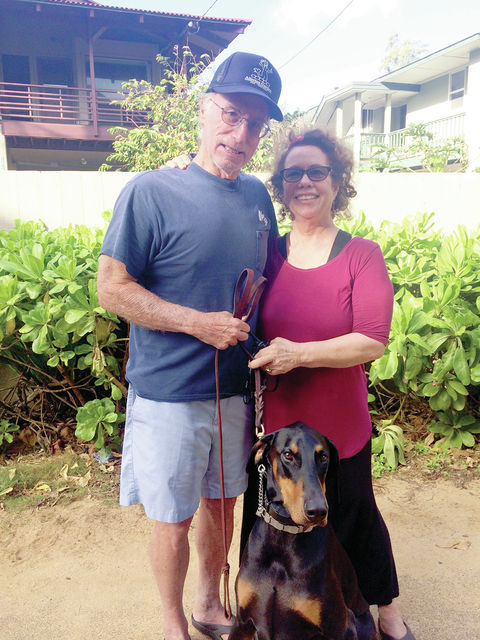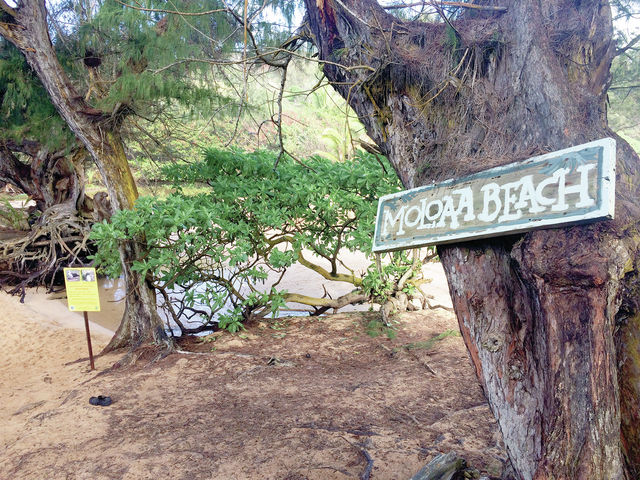MOLOAA — A distinct odor saturates the area around Moloaa Bay during heavy rains, and it smells like sewage, according to area residents. “It’s always after it rains quite a bit,” said Toni Wagner, who lives next to the beach
MOLOAA — A distinct odor saturates the area around Moloaa Bay during heavy rains, and it smells like sewage, according to area residents.
“It’s always after it rains quite a bit,” said Toni Wagner, who lives next to the beach with her husband, Ron, and their dog, Chet.
The couple walks Chet daily on the access road to Moloaa Beach and he loves to play in the water. They often see children and families playing in the stream and they can’t blame them because “it looks so inviting.”
“I’m not sure what they can do about it,” Toni said. “But posting signs would probably help when it’s really bad. It would let families know.”
The Wagners’ theory is that the smell comes from sewage that leaks into the water from cesspool systems upstream and is blocked by a sand bar in the stream, Ron said, and when the water level rises it’s pushed downstream.
That theory is shared by the state’s Department of Health, along with a couple other theories, which are sending staff members of the Clean Water Branch to sample this stream.
The DOH Beach Monitoring Program prioritizes beach sampling based on beach usage into three tiers, tier one being the highest priority. Moloaa Stream is a lower use tier three beach, which isn’t monitored by DOH on a regular basis.
If there are elevated counts of the enterococci bacteria that exceed the Beach Action Value of 130 cfu/100 ml, the DOH will post caution signs to warn the public of high bacteria.
Some of that testing has already been done by the Surfrider Blue Water Task Force, which traditionally samples the area, though the actual sampling site changed in September.
Blue Water Task Force has been sampling offshore at the surf site for years, but they decided to sample at Moloaa Stream because people in the Moloaa community were concerned about the stream’s smell.
In September, the bacteria count from the Surfrider samples in Moloaa Stream was 388 cfu/100 ml. October’s count was 554, November’s count was 228, December was at 542, and this month’s sampling, taken Jan. 14, was 4,106 cfu/100 ml.
For September through January, the Blue Water Task Force’s geometric mean measurement, or the average of the five samples, was 642.2, according to Carl Berg of Blue Water Task Force.
February’s samples, taken Feb. 4, showed enterococcus bacteria concentration at 459 parts per 100 ml.
The geometric mean shouldn’t surpass 35, and if the Beach Action Value is exceeded more than 10 percent of the time, signs should be posted, he said.
“In this case, it has exceeded 100 percent of the time,” Berg said.
DOH staff believes the high enterococci counts may be due to non-point sources from Moloaa Stream, due to the rural agricultural nature of the area, according to DOH spokeswoman Janice Okubo.
“However, there may also be some risk associated with cesspools from the dozen or so houses along Moloaa Bay,” Okubo said.
Cesspool pollution
The island of Kauai has 18,000 cesspools, according to DOH, and has the highest density of cesspools per square mile in Hawaii.
In order to address the issue of cesspool pollution throughout Hawaii, DOH has partnered with the federal Environmental Protection Agency to create the Cesspool Working Group, which is developing programs and plans of action.
In the Legislature, Act 120 created a $10,000 income tax credit for septic upgrades, as long as cesspools qualify under the requirements and the conversion is to a septic tank or aerobic treatment unit, or connection to a sewer system.
New bills have also been introduced this session to address cesspool issues.
Bob Warfield from Santa Cruz, Calif., is a regular visitor to Kauai, who rents a house in Moloaa when he comes to the island. He said the stream’s water quality is upsetting.
“I like to swim there, but last year I spent the better part of two days at the doctor getting my ear infection cured,” Warfield said. “It’s more than a passing interest to me. I’ve been coming to Kauai since I was 12 and I’m 74.”
But it’s not just the quality in Moloaa Stream that has Warfield concerned.
“The Waiopili Stream over in Mahaulepu is on the other side of the island and look at those numbers,” he said. “It seems like it’s a problem all around the island.”
The DOH has been collecting and analyzing water samples at the Waiopili Ditch in response to a complaint from the Kauai Surfrider chapter and Okubo said the results exceeded the standard BAV.
DOH has posted caution signs in the area, though testing is showing that the source of bacteria at the Waiopili site doesn’t appear to be from human sewage, which is a higher health risk.
DOH has also contracted with University of California, Lawrence Berkeley National Laboratory to determine the non-human source or sources of the enterococci using its PhyloChip Microbial DNA Fingerprinting technology.
“This test involves collection of water, soil, sediment, decaying organic matter and fecal matter from animals and birds, under very tight quality control conditions to prevent DNA contamination,” Okubo said.
A draft report on the results is expected in April, with the final report coming in June.
“With the DOH, where they put up warning signs and say ‘Stay out, this area is contaminated,’ then they need to figure out the source and clean it up,” Berg said.
When it comes to Moloaa Stream’s water quality, DOH tests will reveal soon the quality at the time of testing and then DOH will move from there.
“Monitoring the beaches of Hawaii is of great importance to the state of Hawaii and DOH,” Okubo said. “The department sees the value of citizen-based monitoring.”



